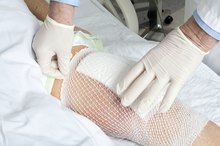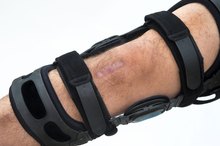What does fact checked mean?
At Healthfully, we strive to deliver objective content that is accurate and up-to-date. Our team periodically reviews articles in order to ensure content quality. The sources cited below consist of evidence from peer-reviewed journals, prominent medical organizations, academic associations, and government data.
The information contained on this site is for informational purposes only, and should not be used as a substitute for the advice of a professional health care provider. Please check with the appropriate physician regarding health questions and concerns. Although we strive to deliver accurate and up-to-date information, no guarantee to that effect is made.
What Causes Fluid to Build Up After a Knee Replacement Surgery?
Knee Replacement Surgery
Knee replacement surgery, or a knee arthroplasty, relieves pain and repairs damage to a diseased knee joint. Mayo Clinic staff describes the surgical process. Surgeons cut damaged bones and cartilage out of your thighbone, shinbone and kneecap. They replace damaged parts with artificial joints constructed out of metal alloys, plastics and polymers. Polymers, a chemical compound, dissolve and absorb in the body as new bones begin growing. The type of artificial joints chosen by your doctor depends on your age, weight, activity level and health. The artificial limbs mimic the natural hinge movements of your knee joints. The American Academy of Orthopaedic Surgeons website says it takes between three to six months for swelling to subside 2. Fluid buildup sometimes develops after knee replacement surgery.
If you are experiencing serious medical symptoms, seek emergency treatment immediately.
Mayo Clinic staff says knee replacement surgery helps pain and disability associated with osteoporosis, rheumatoid arthritis and avascular necrosis, a condition that develops when bone tissue dies because of restricted blood flow.
- Knee replacement surgery, or a knee arthroplasty, relieves pain and repairs damage to a diseased knee joint.
- The American Academy of Orthopaedic Surgeons website says it takes between three to six months for swelling to subside 2.
Dressing
Surgeons put bulky dressings on your knee after surgery to prevent fluid buildup around the knee. Mayo Clinic staff says these bandages stay on your knee for a day or two to make sure fluid is draining properly. If you don’t care for your wounds, fluid will build up because of lack of blood flow. Wear elastic hoses and compression stocking sleeves to assist circulation in your legs and prevent fluids from pooling around your knees.
- Surgeons put bulky dressings on your knee after surgery to prevent fluid buildup around the knee.
- Mayo Clinic staff says these bandages stay on your knee for a day or two to make sure fluid is draining properly.
Infections
Problems with Partial Knee Replacements
Learn More
Infections cause fluid buildup. Mayo Clinic staff says infections develop years after surgery, caused when bacteria travels in your bloodstream to the incision site. Symptoms of infection include:
- fluid drainage in the surgical site
- fevers higher than 100 degrees
- chills
- redness
- tenderness
- swelling
Doctors prescribe antibiotics to get rid of infections. If antibiotics don’t work, you have to undergo surgery to replace the infected joint with a new one to correct the condition.
- Infections cause fluid buildup.
- Mayo Clinic staff says infections develop years after surgery, caused when bacteria travels in your bloodstream to the incision site.
Deterioration
Fluid buildup occurs after knee replacement surgery with increased wear and tear. The American Academy of Orthopaedic Surgeons says athletic activities loosen small particles referred to as “wear debris” in the joint, causing pain and fluid buildup 2. Stress results in fluid buildup and inflammation near loose joints. To prevent pain and inflammation, you will need a revision operation.
- Fluid buildup occurs after knee replacement surgery with increased wear and tear.
- To prevent pain and inflammation, you will need a revision operation.
Related Articles
References
- Mayo Foundation for Medical Education and Research
- American Academy of Orthopaedic Surgeons
- Hatten, B. My Knee Guide. Knee motion. Updated August 15, 2016.
- Hwang BH, Nam CH, Jung KA, Ong A, Lee SC. Is further treatment necessary for patellar crepitus after total knee arthroplasty?. Clin Orthop Relat Res. 2013;471(2):606-12. doi:10.1007/s11999-012-2634-7
- Cross, MB. American Academy of Orthopaedic Surgeons. Revision total knee replacement. Updated May 2015.
- Hatten, B. My Knee Guide. Infection: an uncommon but serious complication after knee replacement. Updated May 30, 2016.
- John M. Eisenberg Center for Clinical Decisions and Communications Science. Preventing blood clots after hip or knee replacement surgery or surgery for a broken hip: a review of the research for adults. 2012 Aug 30. In: Comparative Effectiveness Review Summary Guides for Consumers [Internet]. Rockville (MD): Agency for Healthcare Research and Quality (US).
- Yu S, Garvin KL, Healy WL, Pellegrini VD Jr, Iorio R. "Preventing Hospital Readmissions and Limiting the Complications Associated With Total Joint Arthroplasty" J Am Acad Orthop Surg. 2015 Nov;23(11):e60-71.
Writer Bio
Based in Tucson, Ariz., Cicely A. Richard has been writing since 1996. Her articles have been published in the “Arizona Daily Star” newspaper and “ForeWord Magazine.” Richard earned Bachelor of Arts degrees in English and journalism from Louisiana State University. .






